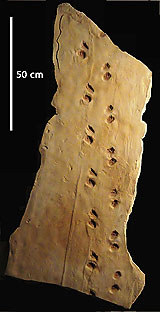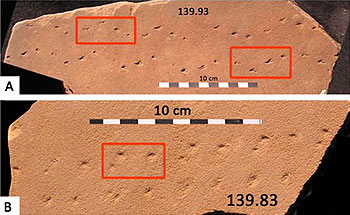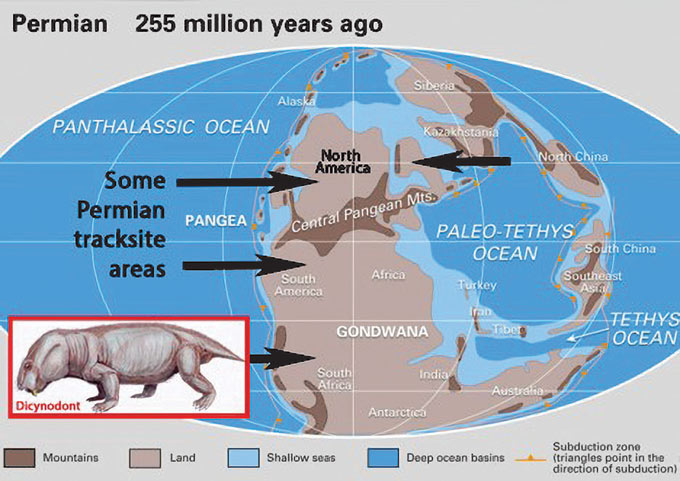 |
| Trackways named Chelichnus are the most common types found in the Permian sandstones of the southwest. The name means “turtle trace” based on incorrect 1800s interpretations and experiments with turtles. But the tracks represent protomammals known as synapsids. |
We ended last year’s People in Paleo with me admitting that I am a “tracker guy.” This means that I do not spend much time looking for bones or even for clams, snails or plant fossils. This is not because I am not interested in such fossils. They are all important in the overall picture of prehistoric life. Rather these days, there is a lot of specialization. Some paleontologists study only carnivorous dinosaurs, other study only fish or clams. I study mostly tracks, and that is a full-time job, because there are so many of them. Many Utah counties have produced hundreds of tracksites, each one with anywhere from just a few to more than 2000 tracks, and new sites are found regularly. For continuity with last month’s piece (Happenings Dec 2022), I will this year have something to say about the six sites that the BLM and USDA Forest Service have designated as destinations that showcase and interpret the Moab area’s fossil footprint resources. I am calling this year’s series The Art of Tracking, some colleagues in the tracking field – also known as Ichnology, where ichnos means ‘trace’ – say the field is ‘part art, part science.’ To illustrate this point there is an almost mystical reverence for the skills of close-to-nature native trackers who can read the subtle signs of behavior left by modern animals. On the other hand, most articles on fossil footprints have appeared in scientific journals, and CSI stories combine both science and the clever reading of subtle clues.
 |
| Spider trackways (A and B) from Permian desert sandstones of Utah and Arizona (University of Colorado collections). Note L-shaped sets of four tracks on each side (in boxes). These reveal complete 8 track pattern which gives us the name (Octopodichnus = trace of 8 feet). |
As far as the greater Dinosaur Diamond area is concerned there are already hundreds of papers published on fossil footprints that range in age from before the age of dinosaurs to the present day. With so much to choose from let us begin near the beginning. The first animals to walk on land were probably half billion (=500 million) year old rolly-polly-like or trilobite-like arthropods, but it was not until much later, closer to 350 million years ago, that tetrapod animals such as amphibians and early reptiles first walked on land. The Grand Canyon and Monument Valley areas are known for having produced tracks dating to the Permian Period (300-250 million years). This was also the time when some animals began to
leave the wet coastal swamps and colonize drier land in the continental interiors. Many Permian deposits represent desert sand dunes with few body fossils. However, surprisingly, given that deserts might not contain abundant life, tracks are quite abundant and represent
both the invertebrate and invertebrate worlds. Among the most distinctive tracks are spider tracks named Octopodichnus, reminding us that spiders, like scorpions, are arachnids with eight legs. The most common vertebrate tracks are named Chelichnus, and look rather like the tracks of a small cat-sized mammal. Although they got their name, meaning “turtle traces,” from a 19th century British paleontologist who thought they were made by turtles)!. These tracks were in fact made by so called protomammals or synapsids. These animals are usually seen as having pioneered the colonization of the continental interiors, by adapting to drier conditions through burrowing underground and regulating their body temperatures through the development of fur as insulation. They represent an early pre-dinosaurian split between the mammal and reptile lines, and remind us that our mammalian heritage is very old. The tracks and trails found in Southern Utah and Arizona are found worldwide in the Permian when the super-continent Pangaea dominated the globe.
 |
| Permian tracks from desert areas show that mammal-like reptiles or protomammals known as synapsids successful adapted to dry desert regions across the supercontinent of Pangaea.. Examples included the “dicynodonts” named for wolf-ike teeth. |
|